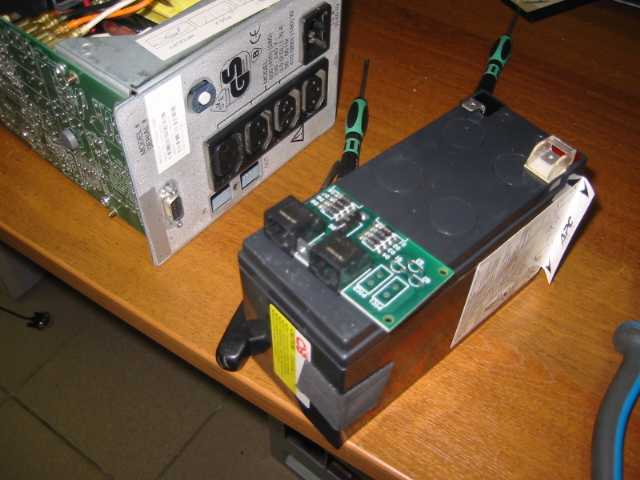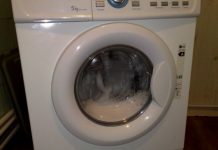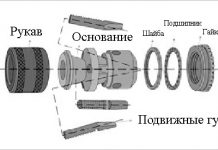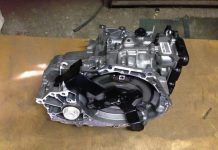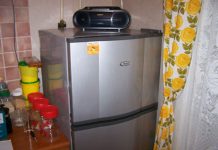In detail: do-it-yourself UPS battery repair from a real master for the site my.housecope.com.
my.housecope.com/wp-content/uploads/ext/42



Probably, many have uninterruptible power supplies (UPS) that do not work due to a “dead” battery. For certain reasons, batteries in uninterruptible power supplies do not work as long as they can under the correct operating conditions.
These batteries must not be thrown away because they contain lead, which is a heavy metal. Purchasing a new battery for UPS is often impractical, because the cost of the battery is slightly less than the cost of a new, more powerful uninterruptible power supply.
You can try to recover such a battery. Since lead acid gel batteries are maintenance free, there is no guarantee that recovery will be successful. Nevertheless, the probability of success is high and it is better to try to restore the battery than it will lie for several years and end up in a landfill.

So, we have a gel lead-acid battery. Voltage is zero volts, charging current is zero amperes. Pry off the plastic cover with a screwdriver and carefully remove it. In several places it is glued with glue. Under the cover there are rubber caps, their purpose is to release the gases formed during the operation of the battery.
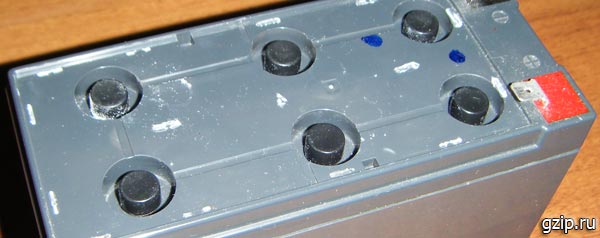
Remove the caps and add 3 ml of distilled water to each can. Tap water and boiled water must not be used. Distilled water can be found at drugstores, auto parts, or from a distiller. Some people use melt water from snow.

After that, the battery should be discharged to 11V by connecting a load - for example, a 15W light bulb. After the battery is discharged, it is necessary to repeat the charge with a current of 600mA. Several charge-discharge cycles can be done.
After recovery, the battery can be used normally. The battery capacity is likely to be smaller, it will drain faster, but it will still work.

How to properly charge the battery
After the battery is restored, it can be charged in the usual way for this type of battery, which in the simplest case may look like this: the battery is connected to a stabilized 14.5V voltage source. A wire-wound variable resistor of appropriate power is installed in the open circuit, which sets the required current. Instead of a variable resistor, you can install a current stabilizer. The current value is taken as the battery capacity divided by 10. For example, with a 7Ah capacity, the charging current should be 700mA. After turning on the power supply with a variable resistor (or stabilizer), it is necessary to set this current. The voltage remains unchanged during charging!
| Video (click to play). |
As the charging progresses, the current will begin to drop, so you need to monitor the ammeter readings and reduce the resistance of the variable resistor in order to maintain the set current. At some point, the resistance of the resistor will turn out to be zero, in this mode, you can stop tracking: the current will gradually decrease and it will no longer be possible to increase it, because voltage is constant - 14.5V. When the value of the flowing current becomes almost zero, the battery is charged.
It should be remembered that lead acid batteries must not be discharged below 11 volts.
UP 16.06.2012
Sometimes it happens that a remanufactured battery does not work satisfactorily: its capacity turns out to be too low and it holds a charge under load for literally several days (while others work under such a load for weeks). What could be the reason - is the resource of these maintenance-free batteries really so small?
To check what's the matter, we disassembled such a battery.
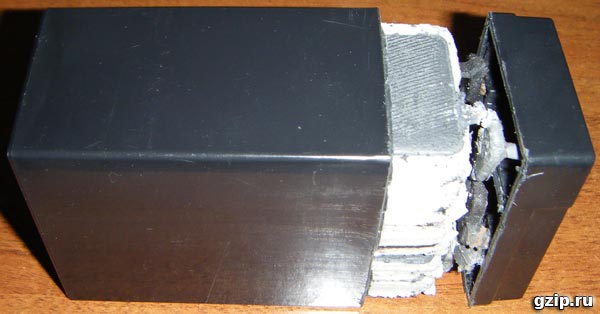
The condition of the plates and the material impregnated with electrolyte is not satisfactory. There is not even the slightest traces of sulfation, and the closure of the plates is all the more impossible due to the high density of the material between them. What causes the irreversible loss of battery capacity?
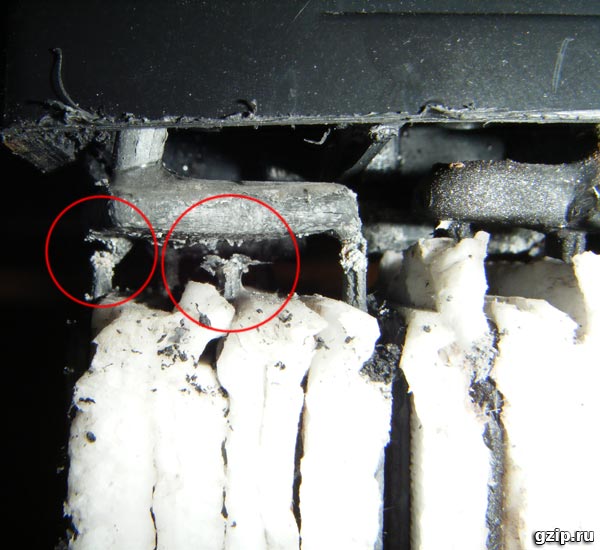
The point is “decaying” the plates. The place in which the plate connects to the can's outlet seems to be made thin on purpose. As a result, it is there that the electrochemical destruction of lead and the destruction of the contact occurs. For this reason, when recovering and recharging such batteries, individual cells become hot and the charge current can jump unexpectedly.
If this unit had a larger cross-section, the resource of sealed lead-acid batteries would be many times longer, but this is probably not profitable for manufacturers.
Hello everyone! Surely, many people have non-working lead-acid batteries at home, for example, from an uninterruptible power supply. Usually, these batteries have good voltage, but the amperage is low. That is, under load, there is a voltage drawdown immediately. I have two such batteries: one for 6 volts, the other for 12. If you also have such batteries lying around, do not throw them away, because most likely they can be restored.
To restore the battery, we need:
- Electrolyte (use distilled water as it is an affordable and cheap option)
- Syringe (can be bought for a penny at any pharmacy)
The first step is to open the covers on the top of the battery. They are usually glued with glue.
On 6-volt batteries, there is usually one cover that looks like this:
When the covers are removed, you need to remove the second, rubber covers. They are much easier to remove than the previous ones as they are not glued. When removing these plastic covers, the main thing is to remember which place, which cover, this will save you time when assembling.
In my case, there are 3 covers on a 6-volt battery.
On a 12 volt 6 covers.
Now we take the electrolyte and pour it into some container, where it will be convenient to lower the syringe. In my case, this is a plastic disposable cup.
Next, we draw up the liquid with a syringe and pour it into each can of the battery, one by one. Pour until the material inside the battery (fiberglass) becomes wet and stops absorbing moisture. It took me 2 syringes for each can.
After filling with electrolyte, the battery became noticeably heavier than it was.
Next, take the rubber covers and put them back on. Then we close the plastic cover and glue it with a second type superglue.
After that, nothing special, just put the battery on charge for a long time. In this way, I have successfully restored my 2 batteries.
So this method really works. Good luck to everyone and if you have any questions - read the forum!
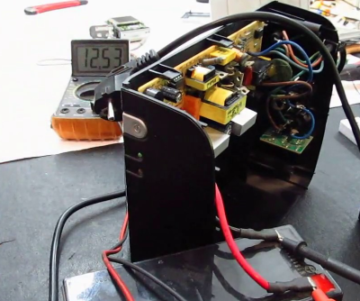
People who use uninterruptible power supplies may face a situation where the device cannot keep the equipment in working order even with the slightest power surge. This happens because the battery of the device is out of order. In such cases, the restoration of the uninterruptible battery can significantly save on the purchase of a new expensive battery. There are several methods to help you get your equipment up and running.
According to experts, a breakdown of the battery can be caused by various reasons:
- Regular undercharging of batteries in uninterruptible power supplies - this reason is much more common than others, because economy-class sources are usually equipped with poor quality chargers;
- Poor quality of the input mains voltage - it is because of it that the device often has to turn on the battery mode;
- Uninterruptible power supplies are charged too deep;
- The reasons for the failure may also lie in the fact that the battery has been in a discharged state for a long time;
- The UPS itself can discharge the battery, but this indicates a malfunction in the equipment circuit;
- The electrolyte level decreases due to increased voltage during charging, as a result of which the battery begins to dry out and lose its original qualities;
- Operation of an uninterruptible power supply in conditions with high air temperatures
All of the above factors negatively affect the performance of the battery and lead to breakdowns:
- The active mass of positively charged electrodes begins to creep and crumble due to its loosening and loss of homogeneity;
- Deterioration of the mechanical strength of down conductors;
- Weak adhesion of the active mass;
- Corrosion destruction of electrodes, in which electrochemical processes of oxidation and dissolution occur in electrolytes, and the material of the down conductors crumbles;
- Sulfation of the plates occurs in UPS batteries, as a result of which reversible current-forming processes stop.
Replace battery mode (replace battery), as a rule, is switched on on an uninterruptible power supply in the event that the electronics are out of order: either a strong wear of the battery or a lack of contact.
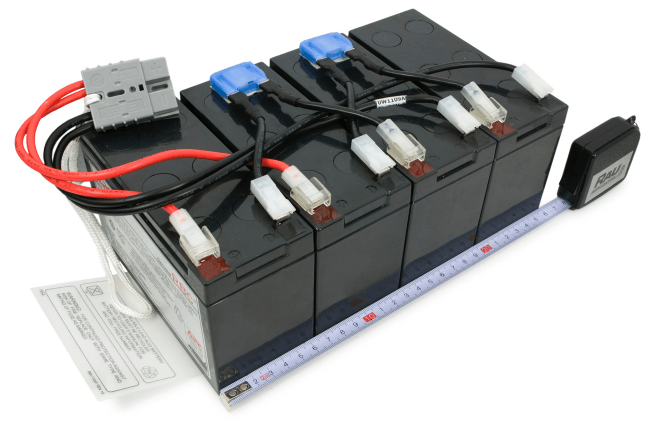
The light on the device starts blinking or is constantly on, in addition, many models emit a characteristic squeak.
If the battery lay without action for a long time, was used too actively or in the wrong conditions, then you can start restoring damaged elements. Thanks to special methods, you can:
- Clean the plate from lead destruction products;
- Improve the density and homogeneity of the mass of positively charged electrodes;
- Improve the condition of the electrodes, which began to destroy corrosion.
To recover the battery of the UPS equipment, tried many ways, some of them have proven to be quite effective. In order for the battery in the uninterruptible power supply to work for some more time, you can try the following methods:
- Recovery with distilled water;
- Recovery by long battery charging;
- Cyclic charging.

- It is necessary to carefully remove the top battery cover that covers the can caps;
- The caps are unscrewed, which additionally function as valves to relieve excess pressure when the device is heated;
- The syringe is filled with about 2 ml of distilled water;
- The liquid is slowly squeezed out 2 ml into each jar.
Water absorbed for about half an hourand the plates should be slightly damp.
If the first time there was no improvement, then the procedure can be repeated.
The long-term battery charging method is an effective way to restore the UPS to its original current, voltage, and capacity. It is used more often than others because it does not require disassembling the equipment case.
The execution scheme is quite simple:
- The battery case must be covered with a lid and pressed down with a small weight so that the caps do not fly apart under the influence of excessive pressure;
- You can charge from a home power supply or a transformer;
- Minimum mains voltage - 15 V;
- Charging may take a long time.For example, a battery often takes about fifteen hours just for the battery to start drawing electrical current. If it still does not start charging within a given period of time, then you need to raise the voltage to 20 V;
- Serviceability is checked using the Digitemp program.
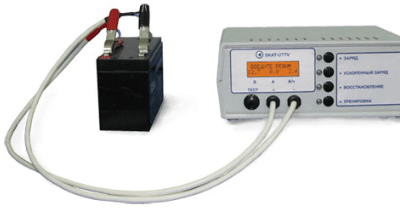
- To restore the original properties of the UPS server, it is recommended to use a high voltage - up to 30 V;
- Each subsequent cycle should take place with a stepwise decrease in voltage to 14 V;
- The battery is discharged using a small 5-10 W lamp;
- In the process of discharging, the voltage should be monitored so that a drawdown does not occur below 10.5 V;
- Five cycles are usually carried out.
There are other ways to restore the working functions of the battery, some of them can be found on the forum lissyara 2006.
Of the more radical methods, you can try the following:
However, if all the recommended methods were used, and it was not possible to obtain a positive result, then it is necessary to replace the battery in the UPS.
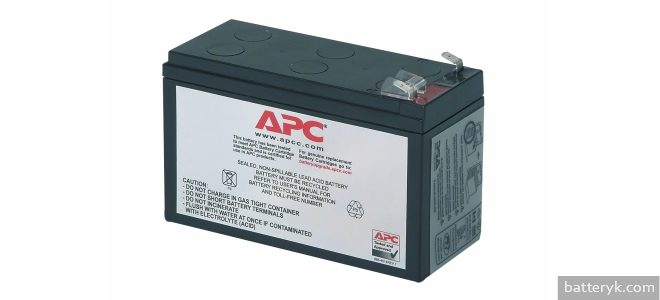
It's no secret that sooner or later any battery loses its capacity and gradually starts to keep its charge worse and worse. In addition, the battery can be discharged suddenly, due to the fact that it depletes the resource due to too much load. The same applies to uninterruptible power batteries. It is just as possible to restore the uninterruptible battery as it is to "bring to life" any other battery power supply unit. Purchasing a new battery is also an option. But practice shows that with a great desire and skill, you can restore the capacity of the UPS battery with your own hands.
Uninterruptible power supplies (popularly called oops) may stop working for the following reasons:
- In case of constant undercharge, which does not make itself felt at first ... The fact is that "standard" chargers, which often come with a UPS, are of poor quality and do not charge the battery well.
- Regular voltage drops in the mains .
- Power supply is deeply discharged .
- The electrolyte level of the battery decreases for various reasons ... The electrolyte dries up, and the capacity of the batteries drops, or is completely at zero.
- If the operation of the lead-acid batteries of the UPS was carried out either at very high, or, conversely, at critically low temperatures .
- The battery has been out of work for a long time and has not been charged for a long time .
There may be enough reasons for a UPS failure. The question is, is there anything that can be done with dead batteries and how to restore them so that they work for some more time. It should be said right away that, despite the ability to "reanimate" the uninterruptible power supply, this cannot be a 100% guarantee that the restoration will be crowned with success. However, it doesn't hurt to try one or another recovery experience. And if none of the methods are effective, you will have to buy a new battery.
There are many videos on the internet on how to restore a UPS.
There are at least three working methods for self-recovery of such batteries:
- using distilled water;
- long charging method;
- by the method of cyclic charging by stepwise supply of voltage of various levels.
Those who reconditioned batteries with distilled water have different opinions about this method. In some cases, it is possible to restore the capacity of the battery at least partially, which is already good.
To do this, you need a regular medical syringe and some distilled water. Since all batteries are traditionally divided into serviceable and maintenance-free (or low-maintenance), inspect the battery carefully to understand what category it belongs to.If your UPS has a liquid electrolyte inside, it is maintainable, and it will be extremely easy to get access to its "banks". But even on the case of the battery it is indicated that it is supposedly maintenance-free - there are still covers on it, and all you need is to remove them as carefully as possible.
Put 2 ml of distilled water into a graduated medical syringe and top up each jar of UPS with 2 ml - in order. Wait a little time for the water to be absorbed into the internal chemical composition of the battery - even if the electrolyte is dry, a certain amount of it should still remain. Usually the waiting time is about half an hour ... After 30 minutes have passed, inspect each jar. The water should cover the top of the battery plates slightly. If it is absorbed and the plates are not yet covered, add another 2 ml of distilled water. Then you will need to put the UPS to charge.
Charging is done as follows: the battery is connected to a power supply unit with the ability to manually adjust the current and voltage indicators. Increase voltage carefully until you get a current indicator of at least 10-20 A. The current will increase, and the voltage, on the contrary, will decrease. Wait until the current level reaches 200mA, then disconnect the battery from the charger and leave it in this position for 12 hours ... Thereafter put it on charge again , aligning the current and voltage indicators as follows: for example, for a 7 Ah battery, the current indicator can be left at 600 mA.
Now you need it again drain the battery up to a voltage of 11 V under load (for example, a 15 V light bulb). Again charge it in the same way .
If, during charging, when measuring current and voltage with a multimeter, the battery begins to "respond" positively, charging must be continued, and the chances of restoring the UPS are increased.
There is also a method of so-called long-term charging, which is said to help restore the battery even if its electrolyte dries out. Such a recovery of the uninterruptible battery is carried out if there is no desire to disassemble it and tinker with distilled water. The method is not entirely safe, because, in this case, the battery is not opened, but, on the contrary, it is recommended to put a load on its plugs and valves before charging so that they do not fly out under high pressure, which will rise during the charging time.
After placing the load on the battery, it is recommended to charge it under a voltage of at least 15 volts. In this case, you will still have to wait until the battery "swings" and starts to consume the current supplied to it. If 12-15 hours have passed, and your UPS is still "sleeping", increase U to 20 volts.
Now do not leave the battery unattended : if you manage to "wake up" it, consuming current, it will start to boil quickly. It is believed that with such an increase in the voltage level, the uninterruptible power supply can be brought to life. Next, you should hold it a little more on charging with medium currents (up to 10 A), and then try to use it as usual.
As for the method of cyclic charging, it is possible to restore the UPS battery with its help. But you should carefully monitor the indicators, especially at the beginning of the charging process. On the first cycle, a high voltage is applied, at least 30 volts. Subsequent cycles are carried out by stepwise lowering the U indicators to 13-14 volts, for example, according to the following scheme: 30-25-20-14 ... We discharge the battery, as always, under load, with a light bulb, avoiding a strong "drop" in voltage - U must be at least 10.5 volts.
It is important to remember that the condition of your battery varies. For instance, if the plates have already shattered inside, or sulfation has reached a certain critical limit, such a battery cannot be restored ... For "uninterruptible power supplies" that have been lying in unheated rooms with a high level of humidity for a long time, rotting of the battery compartments is characteristic, due to which the battery will never be able to draw current, and connecting it to the network can even be dangerous.
Of course, no one can say with certainty which of the proposed methods will be the most effective in this or that case. Subject to certain safety precautions, it will not harm either the battery or its owner. And if the uninterruptible power supply can still be restored at least for some time, the purchase of a new battery can be postponed for a while.
Many owners of uninterruptible power supplies have been in a situation where, at the slightest power surge, the computer turns off, although it was connected to the UPS. The reason for this is the failure of the batteries, and their price is such that sometimes it is cheaper to buy a new source. Many people immediately have questions: “How to reanimate an uninterruptible power supply? Can the UPS battery be repaired? " We suggest you find out how to restore a battery from an uninterruptible power supply in this article.
To begin with, consider the main types of malfunctions and the reasons why the battery may become unusable. There can be many reasons for the breakdown of the source battery:
- systematic undercharging of UPS batteries is the most common reason, since budgetary sources are equipped with not very high-quality chargers. Also, the reason may be as the input mains voltage, due to which the UPS often has to turn on the battery mode;
- deep discharge - also possible with poor quality input voltage;
- prolonged presence of batteries in a discharged state - after a long work on batteries, try to leave the UPS turned on so that it can fully charge its batteries, there are also situations that the UPS itself discharges the battery, but this problem is associated with physical problems in the circuit;
- a decrease in the electrolyte level, which leads to the drying out of the battery and the loss of its original qualities - this is due to the increased voltage during charges;
- operation of the battery in high temperature conditions and storage at temperatures below 0.
All of the above negatively affects the performance of the batteries in the UPS, and they work poorly or completely fail. The above reasons lead to the following battery breakdowns:
- shedding and sliding of the active mass of positively charged electrodes, which is associated with a violation of homogeneity and loosening;
- weak adhesion of the active mass or poor mechanical strength of the down conductors is the reason for the fall of the active mass;
- corrosion of electrodes, which consists in the formation of electrochemical processes of dissolution and oxidation in the electrolyte, as a result of which the material of the down conductors crumbles;
- sulfation of plates, which consists in the impossibility of reversible current-forming processes as a result of the formation of large crystals of lead sulfate.
The listed problems can be avoided by installing a high-quality charger in the UPS, but, unfortunately, an ordinary person cannot do this, as well as influence the UPS manufacturers. All that remains is to buy higher quality, but at the same time, expensive UPS models.
Now let's move on to the essence of the article - revitalizing the uninterruptible battery at home. One should not expect one hundred percent results, and the methods of revitalization are suitable only for some types of breakdowns, but it is still worth trying to restore the uninterruptible battery, since the prices for new batteries are quite high. Below we will consider several ways to restore batteries.
1. We revive the UPS with distilled water.
First you need to buy the necessary tools: a syringe and distilled water. Distilled water is sold at any car store.To restore batteries in this way, you will have to rip off the top battery cover, which covers the jar caps. Then remove the caps, which are also valves to relieve excess pressure that builds up when the batteries heat up.
Fill a syringe with distilled water, no more than 2 ml, and squeeze it into a jar. Do this for each can. Let the water soak in time (it will take about half an hour), if necessary, fill in more. The plates should be slightly covered with water, if you get an excess, then you can remove it with a syringe.
2. Long-term charging
Restoring the UPS batteries in this way allows you to restore its original properties after drying out. Initially, you can try it so as not to disassemble the battery. If prolonged loading does not help, then you will have to complete the first step. A dry battery will not initially consume current from the charger, so do not pay attention to the ammeter.
Before connecting, cover the battery with a lid and place a weight on it, otherwise the caps will scatter throughout the room, since excess pressure will be released through them.
You need to charge with a voltage of at least 15 volts. And you will have to wait a long time before the battery starts to come to life and take current. If within 15 hours of charging the battery still does not take current, then the voltage should be increased to 20 V. In this case, the battery must not be left unattended, otherwise both the battery and the charger can be damaged.
3. Cyclic charge
If the battery does not want to come to life, then you can try to "shake" it. Charge / discharge cycles should be performed alternately, which will restore the original properties of the battery.
The first charge cycle should be carried out with a high voltage of about 30 V. Subsequent cycles will require a stepwise decrease in voltage to 14 V, for example, 30-25-20-14 V. If there are more cycles, then the voltage indicators will be different. The battery should be discharged with a small 5-10 W light bulb. When discharging, you should monitor the battery voltage and do not allow it to drop below 10.5 V.
The above methods describe how to restore the operation of the UPS, but if they do not help, then you will have to go to the store for a new battery. If you decide to throw away your old batteries, remember that batteries contain lead, a heavy metal, and acid. Ask on the Internet or at any service center where to dispose of batteries from the UPS in your city, so as not to damage the environment.
For any question, you can use this form:
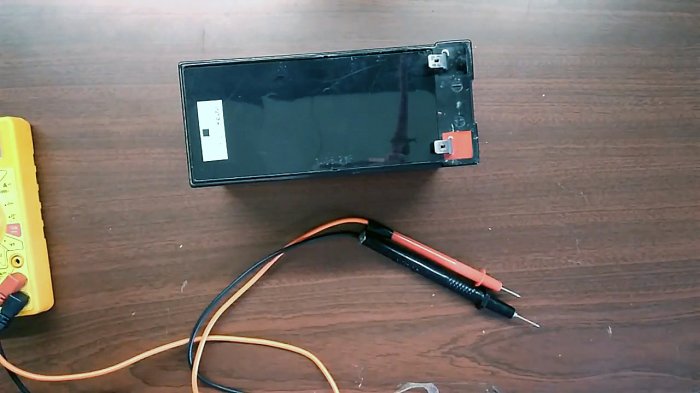
If your uninterruptible power supply for a computer, after a few years, has ceased to hold the load after a power outage, then most likely its battery is out of order. This is the most common failure of uninterruptible power supplies. The repair is extremely simple: replace the battery and forget about the problem for a few more years.
These types of batteries are not cheap. I suggest that you try to restore your battery in a very simple way.
Why is the battery losing capacity and not holding a charge? One of the reasons for the failure of batteries of this type is the drying out of the cans. Therefore, we will just need to add some distilled water to each compartment.
I do not want to falsely reassure you, but the method is not one hundred percent, since the battery may not have lost its capacity due to drying out. Although any restoration is not 100% guaranteed. Therefore, we will only give the battery a chance, which is definitely worth using, since it will not require a solid effort from you, and if the restoration is successful, it will save you good money.
We disassemble the uninterruptible power supply and remove the battery from it. We measure the voltage with a multimeter. If it is below 10 V, then the chances of restoring the battery are negligible, but they are still there.
In a dry battery, the voltage usually fluctuates around 13 V, and when the load is connected, it drops almost immediately.
In my case, everything is bad - 8 V in total.
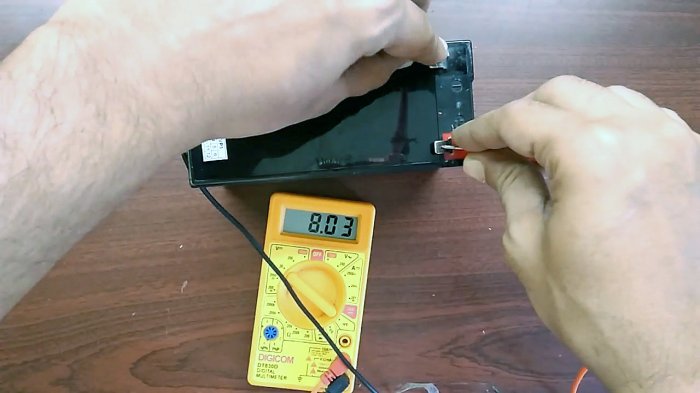
These batteries are non-separable and not intended for service. Therefore, the compartments of the cans are sealed with a plastic strip, which must be pry off with a sharp knife.
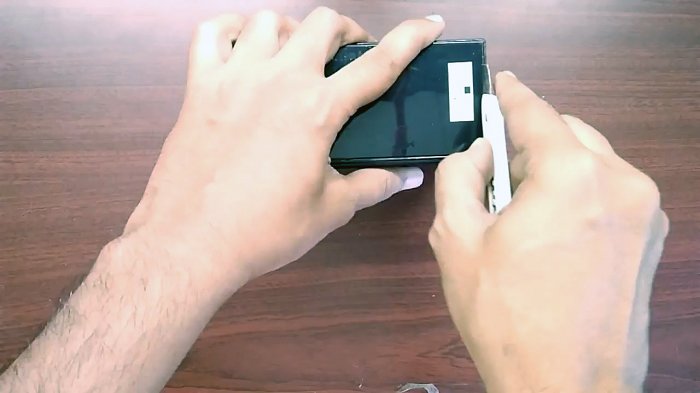
A little skill and if you walk the edge along the perimeter, the plate comes off.
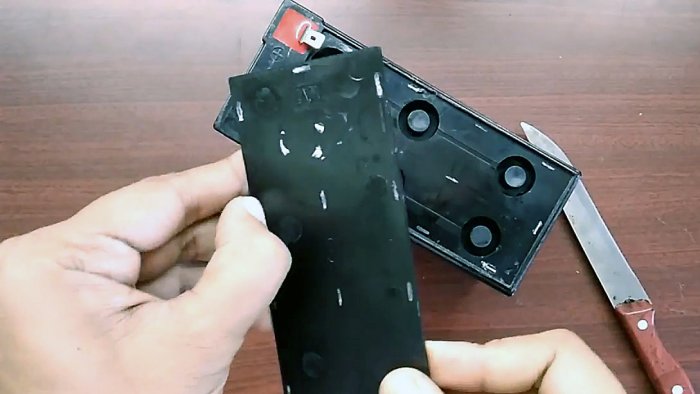
Six rubber caps are visible underneath, for each compartment. These are kind of valves.
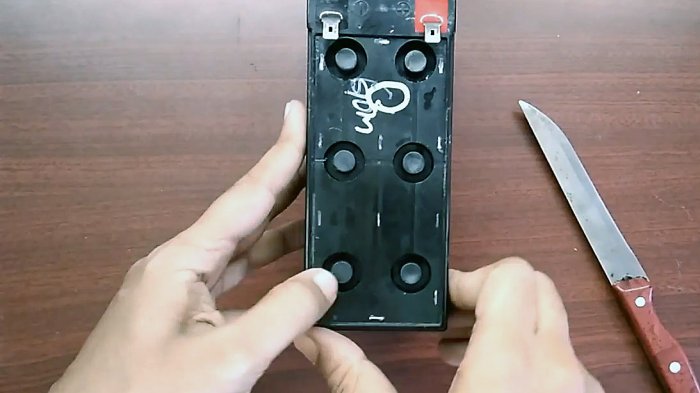
They are simply removed by hand. We remove them all and set them aside.
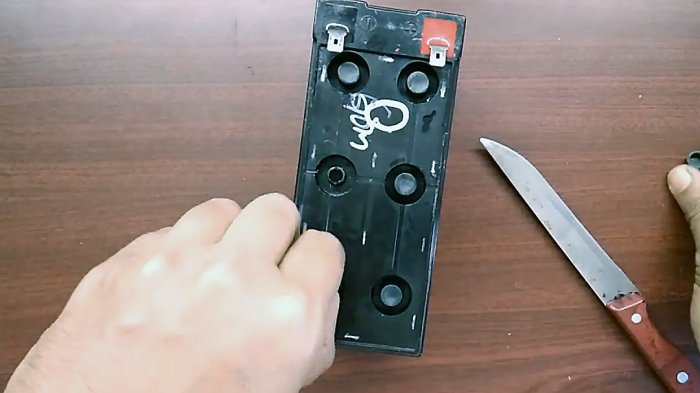
Next, we need to find about 200 ml. distilled water. You can buy it in an auto store or it is very easy to get it at home without special equipment - read how to do this in this article.
You will also need a syringe for 20 cubes. And if not, take any that is available.
Now everything is simple: add 15-20 ml to each compartment. distilled water. It is difficult to say the exact amount, so we pour it into the compartment and look with a flashlight so that it is almost to the top.
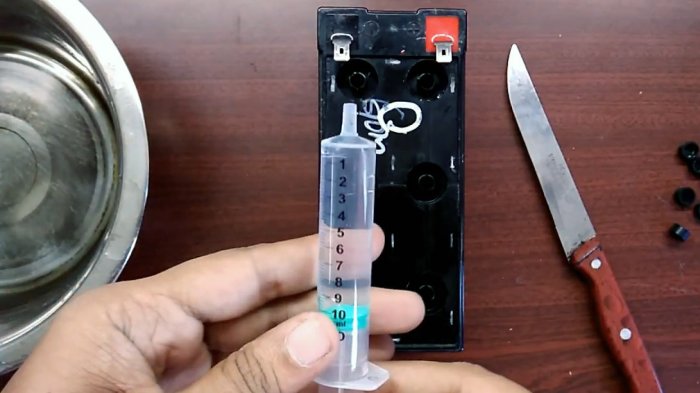
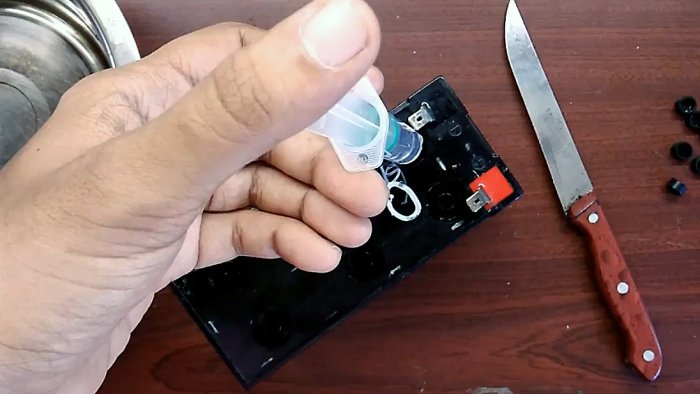
If you wait a little, the water level will gradually decrease as the water is absorbed into the filler, which is located between the lead electrodes.
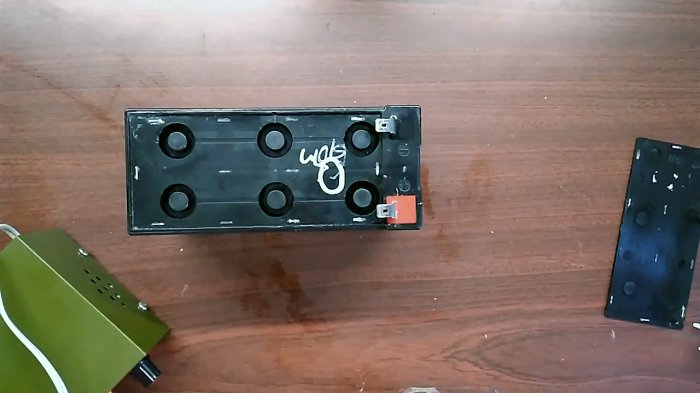
We close the holes with rubber plugs. We connect the charger and try to charge. Of course, the battery can be immediately installed in the UPS, but who knows whether it will be charged there or not.
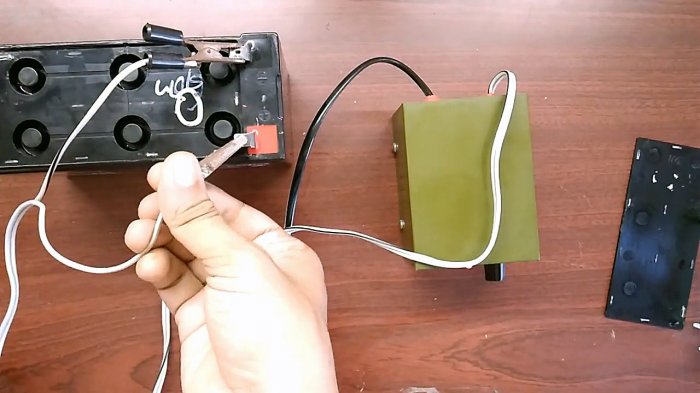
After an hour, we turn off and check the voltage. It has grown to almost 11 V. So the battery is recovering.
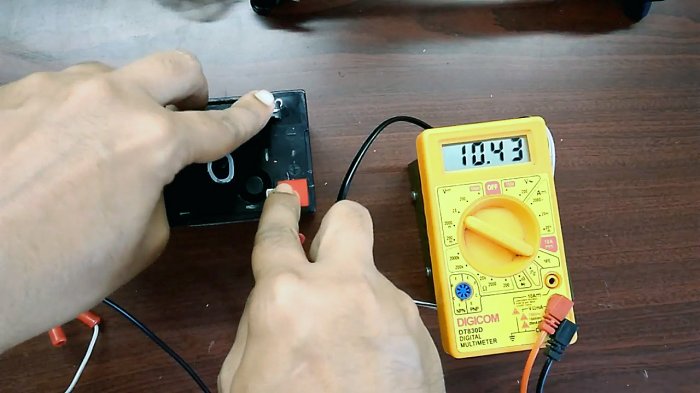
We put the torn off plastic cover on the glue applied to the same places where it was before the factory one.
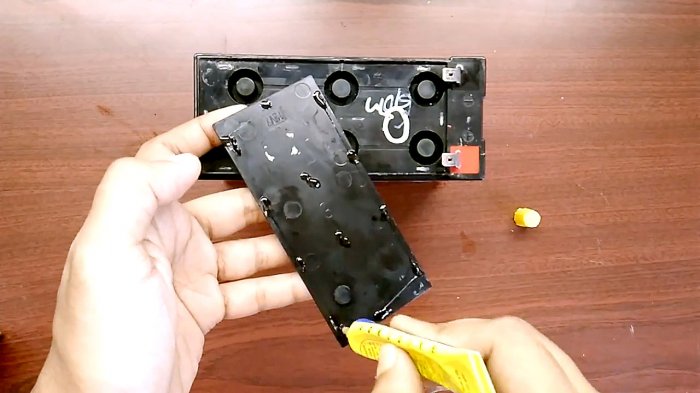
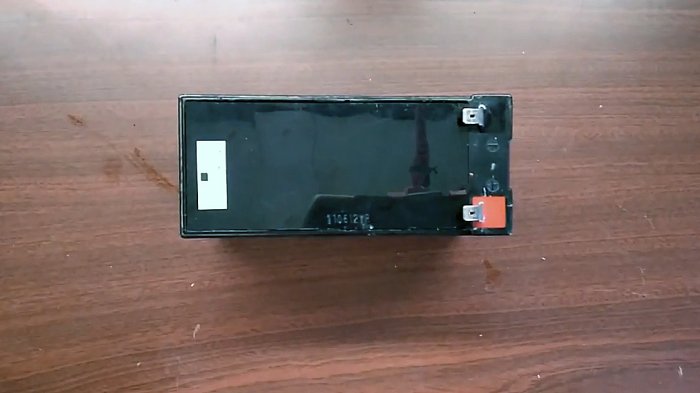
We continue to charge for another 3 hours. And re-measurement shows that the battery is charging.
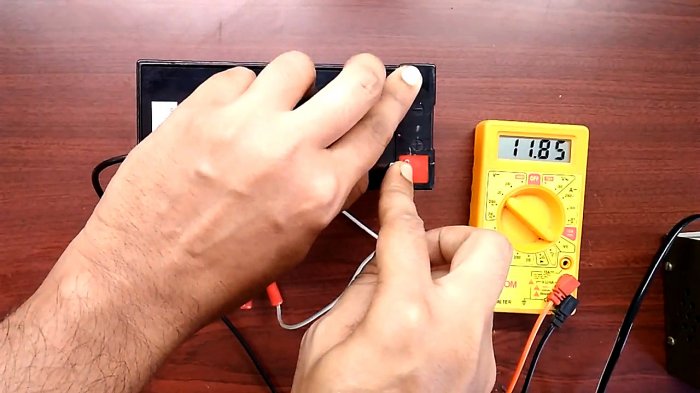
This battery was about 5 years old. She, of course, did not immediately stop holding the charge, but gradually sagged. Now it is brought back to life and has 80% of the original capacity. I think it will last a couple of years without any problems, although who knows ...
Here is the simplest method that will help bring an old battery back to life. Try it yourself, and you will always have time to throw out the battery.
- After 8 minutes, my uninterruptible power supply died, without warnings, and the correct completion of the Windows operation. (This is despite the fact that I hesitated to pick up a cable for it - APC has at least two possible pinouts for COM cables)
- At the 15th minute, two sideboards, powered by one UPS at 700W, were out of order.
- At the 15th minute, the proxy for FreeBSD died, which had a small Back-UPS 475, and on this model a cable for communicating with a computer was not provided in principle, so the work was not completed correctly.
- At the 22nd minute, they turned on the napruga and the experiment ended. Three 24-port switches remained in operation, and a server powered by a Smart-UPS 1500.
As a result, after some combinations and shenanigans with rearranging UPS's, I got the 700th smart, and FreeBSD got mine, which was kind of dead, but with an RS-232 interface (COM port) for pairing with a computer. He fought for a long time, until under the fryukha managed to get her to see him. The result of the last of the experiments was that everything ended correctly, but after turning on the power on the APC-420, a red light began to burn constantly - like the battery was dead:
The first thing that surprised me after disassembling the UPS was that the radiators on transistors of such a small size, I got used to the old mains with conventional transistors, but here there were field-effect ones - as a result, the size of the radiators was reduced by more than an order of magnitude:
I got an APC-420 uninterruptible power supply from the previous admin, all dirty, it was lying in the closet, among other trash. When he asked what happened to him, he said: "The battery is dead, if you need it, order a new battery." Okay, lying around, and lying around, does not ask for food. Forgot.
About six months later, I stumbled upon him by accident, during another fruitless attempt to restore at least some semblance of order in my sharaga.I connected it to an outlet in order to see what the uninterruptible power supplies with a dead battery say and show. He blinked light bulbs, peeped something, then they called me, and they ripped me off somewhere. In general, I found it again only after a couple of months. It stands peacefully, a green light is shining, they say, everything is in order with the voltage in the network. I disconnected it from the mains, it got nervous, squeaked and hummed with tension, continuing to supply voltage to a non-existent load :). After waiting 5 minutes for control, I turned it off and connected my computer through it. I tried how he behaves in the event of a power outage - everything is clear, the computer plows, issues warnings (I licked it with a cable on the COM port), and after 7 minutes the computer is cut down, followed by the UPS.
Once, they turned off the voltage, but they did not warn me in advance. Nothing terrible happened, Almost all of them had UPSs, finished their work and began to wait to be turned on. I didn’t cut anything down, I decided to check in “combat conditions” how long the self-powered equipment will last. Along the way, it turned out that Cisco and the TAYNET DT-128 cable momed are connected directly to the network, without any filters or uninterruptible power supplies.
- After 8 minutes, my uninterruptible power supply died, without warnings, and the correct completion of the Windows operation. (This is despite the fact that I hesitated to pick up a cable for it - APC has at least two possible pinouts for COM cables)
- At the 15th minute, two sideboards, powered by one UPS at 700W, were out of order.
- At the 15th minute, the proxy for FreeBSD died, which had a small Back-UPS 475, and on this model a cable for communicating with a computer was not provided in principle, so the work was not completed correctly.
- At the 22nd minute, they turned on the napruga and the experiment ended. Three 24-port switches remained in operation, and a server powered by a Smart-UPS 1500.
As a result, after some combinations and shenanigans with rearranging UPS's, I got the 700th smart, and FreeBSD got mine, which was kind of dead, but with an RS-232 interface (COM port) for pairing with a computer. He fought for a long time, until under the fryukha managed to get her to see him. The result of the last of the experiments was that everything ended correctly, but after turning on the power on the APC-420, a red light began to burn constantly - like the battery was dead:
The red light on the uninterruptible power supply began to burn constantly, indicating that it was time to replace the battery - like dead.
The first thing that surprised me after disassembling the UPS was that the radiators on transistors of such a small size, I got used to the old mains with conventional transistors, but here there were field-effect ones - as a result, the size of the radiators was reduced by more than an order of magnitude:
Nowadays, they began to use field-effect transistors - they heat up much less than ordinary ones, so the radiators have become very small.
The transition to field-effect transistors made it possible to reduce the size of the radiators for transistors - now they heat up less.
The second thing that is already a good thing is the power of the transformer, which, judging by the marking on it, was equal to 430W, which is even more than the rated power of the uninterruptible power supply unit (it is believed that more powerful uninterruptible power supplies are produced in such a case with minor differences in the circuit and more powerful key transistors):
Oddly enough - the trance is made with a margin :) Something, but this from the cross-eyed I did not expect. (albeit with a small one - 30W, but still)
Another interesting crap in the design, which I did not even notice before, is the ability to connect a network cable via Smart-UPS, for the purpose of additional protection. Upon closer examination, the scheme turned out to be quite simple, and only two pairs are protected through which data is transmitted (for a telephone pair, the protection is divorced, but not unsoldered):
A rather primitive, but effective circuit for protection against high voltage surges:
To restore the battery's performance (12V 7.0Ah, the banks seem to be intact, none of them swelled up.), A simple circuit was assembled for charging with an asymmetric current (I previously discharged it to 10.8 volts with a 21W bulb):
| Video (click to play). |
Charged up to 14.8 volts, and then discharged it again. And so three times. The charging current was about 0.5 A. The first time it was discharged very quickly - literally in an hour. From the second call - for two with a penny, the third time I did not discharge it, I put it in place. When his torment was over, he worked like new.Of course, this did not make him new, but he worked for a long time. In an amicable way - three times is not enough, it was necessary to drive him out like this 5 times, I would have worked much longer (a year later a similar story happened to him, but I did not work there anymore, and I don’t know how everything was decided.).

